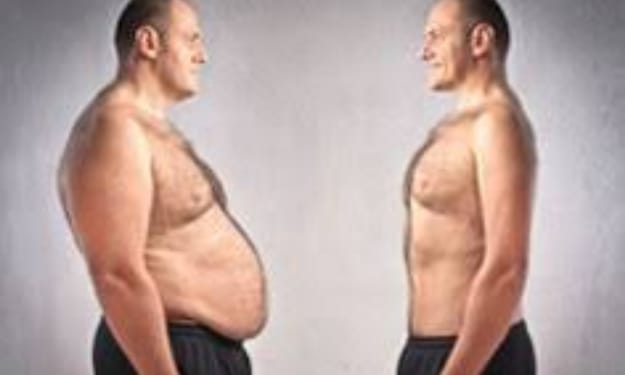
Dietary Approaches to Weight Loss:
One of the most crucial aspects of weight loss is creating a calorie deficit, which means consuming fewer calories than your body needs. This can be achieved through a combination of dietary changes and mindful eating habits. Here are some key strategies to consider:
Calorie Deficit:
To lose weight, it's essential to consume fewer calories than your body burns. This can be achieved by monitoring your calorie intake and ensuring it is lower tha n your Total Daily Energy Expenditure (TDEE), which represents the number of calories your body needs to maintain its current weight. There are several methods to create a calorie deficit:
Portion Control: Keep an eye on portion sizes and aim to consume smaller servings. Using smaller plates, bowls, and utensils can help create the illusion of a larger portion.
Mindful Eating: Pay attention to your body's hunger and fullness cues. Eat slowly and savor each bite, allowing your brain to register satiety signals. This can help prevent overeating and unnecessary calorie consumption.
Balanced Diet:
Adopting a balanced and nutritious diet is crucial for weight loss and overall well-being. Here are some key principles to consider:
Lean Proteins: Include lean sources of protein such as skinless chicken, turkey, fish, tofu, legumes, and low-fat dairy products. Protein helps promote satiety, preserve muscle mass, and aid in the repair and recovery of tissues.
Healthy Fats: Incorporate sources of healthy fats like avocados, nuts, seeds, olive oil, and fatty fish. Healthy fats provide essential fatty acids, promote satiety, and support various bodily functions.
Complex Carbohydrates: Opt for whole grains like brown rice, quinoa, whole wheat bread, and oats. These complex carbohydrates provide fiber, which aids in digestion, promotes satiety, and helps regulate blood sugar levels.
Fruits and Vegetables: Make sure to include a variety of colorful fruits and vegetables in your diet. They are low in calories, high in fiber, and packed with vitamins, minerals, and antioxidants that support overall health.
Minimize Processed Foods: Reduce your intake of processed and packaged foods, as they are often high in added sugars, unhealthy fats, and preservatives. Instead, focus on whole, unprocessed foods.
Meal Planning:
Planning your meals in advance can help you make healthier choices and avoid impulsive eating. Consider the following tips:
Create a Weekly Meal Plan: Plan your meals for the week, taking into account your calorie and nutrient needs. This allows you to make a grocery list and ensures you have the necessary ingredients on hand.
Prep Meals in Advance: Consider preparing and portioning your meals in advance. This saves time during the week and reduces the likelihood of resorting to unhealthy takeout or convenience foods.
Pack Nutrient-Dense Snacks: Instead of relying on vending machine snacks or unhealthy options, pack nutrient-dense snacks like cut-up vegetables, fruits, Greek yogurt, or homemade trail mix. This helps control cravings and provides nourishment between meals.
Intermittent Fasting:
Intermittent fasting is an eating pattern that involves cycling between periods of fasting and eating. It can be an effective approach for weight loss, as it helps reduce calorie intake and improve metabolic flexibility. There are various approaches to intermittent fasting, including:
16/8 Method: This method involves fasting for 16 hours and restricting your eating window to 8 hours each day. Most people achieve this by skipping breakfast and having their first meal at noon, then finishing dinner by 8 p.m.
Alternate-Day Fasting: With this approach, you alternate between fasting days and normal eating days. On fasting days, you significantly reduce calorie intake or consume only a limited amount of low-calorie foods.
Intermittent fasting should be practiced with caution and is not suitable for everyone. It's important to consult with a healthcare professional or a registered dietitian to ensure it is appropriate for your individual circumstances.
Portion Control:
Controlling portion sizes is a simple yet effective strategy for weight loss. Here are some tips to help with portion control:
Use Smaller Plates and Bowls: Research suggests that using smaller plates and bowls can trick your brain into perceiving a larger portion, leading to reduced calorie intake.
Measure Your Food: Use measuring cups, spoons, or a kitchen scale to accurately measure your food portions. This helps you become more aware of portion sizes and prevents overeating.
Listen to Your Body: Pay attention to your body's hunger and fullness cues. Eat slowly and stop when you feel comfortably satisfied, rather than eating until you're completely full.
By implementing these dietary approaches, you can achieve weight loss without relying heavily on cardio exercises. Remember, sustainable weight loss is a gradual process, and it's essential to consult with healthcare professionals or registered dietitians for personalized guidance and support.
TRANSFORM YOUR BODY AND HEALTH WITH OUR PROVEN WEIGHT LOSS SYSTEM – GET STARTED NOW..! https://tinyurl.com/yc8bwv6x

Resistance Training and Other Activities:
While cardio exercises are often associated with weight loss, there are alternative approaches that can be just as effective in helping you shed pounds. These methods focus on building muscle, increasing metabolism, and promoting overall fitness. Here are some key strategies to consider:
Strength Training:
Strength training involves performing exercises that target different muscle groups using resistance, such as weights, resistance bands, or bodyweight exercises. Here's why strength training is beneficial for weight loss:
Increased Muscle Mass: Strength training helps build lean muscle mass. Since muscle tissue is metabolically active, having more muscle increases your resting metabolic rate, leading to more calories burned throughout the day.
Enhanced Fat Burning: Engaging in strength training can stimulate your body's fat-burning processes. As you build muscle, your body becomes more efficient at utilizing stored fat for energy.
Improved Body Composition: Strength training can help reshape your body by toning and defining muscles. This can lead to a leaner and more sculpted appearance.
To incorporate strength training into your routine, consider working with a personal trainer or using online resources to learn proper form and technique for exercises such as squats, lunges, deadlifts, bench presses, and overhead presses. Gradually increase the intensity and resistance over time to continue challenging your muscles.
High-Intensity Interval Training (HIIT):
HIIT is a form of exercise that alternates between short bursts of intense activity and periods of rest or lower-intensity exercise. Here's why HIIT is effective for weight loss:
Increased Calorie Burn: HIIT workouts are highly efficient at burning calories during and after the workout. The intense bursts of exercise elevate your heart rate and metabolism, resulting in an increased calorie burn for hours post-workout.
Time Efficiency: HIIT sessions are typically shorter in duration compared to traditional cardio workouts. This makes them a convenient option for individuals with a busy schedule.
Improved Cardiovascular Health: HIIT exercises challenge your cardiovascular system, leading to improved aerobic capacity and heart health.
To incorporate HIIT into your routine, choose exercises that elevate your heart rate and engage multiple muscle groups, such as burpees, squat jumps, mountain climbers, and high knees. Alternate between 20- to 30-second intervals of maximum effort with 10- to 20-second rest periods. Repeat this cycle for a total of 10 to 30 minutes, depending on your fitness level.
Low-Impact Activities:
Low-impact exercises are gentle on the joints while still providing an effective workout. They can be particularly suitable for individuals with joint pain, injuries, or those who prefer less intense forms of exercise. Consider the following low-impact activities:
Yoga: Yoga combines stretching, strength-building, and mindfulness. It can help improve flexibility, balance, and core strength while promoting relaxation and stress reduction.
Pilates: Pilates focuses on strengthening the core muscles, improving posture, and enhancing body awareness. It involves controlled movements and emphasizes proper alignment and breathing techniques.
Swimming: Swimming is a low-impact, full-body workout that helps improve cardiovascular fitness, build strength, and increase endurance. It is gentle on the joints and is suitable for people of all fitness levels.
Cycling: Whether indoors on a stationary bike or outdoors on a regular or recumbent bike, cycling is a low-impact cardiovascular exercise that helps burn calories, improve lower body strength, and boost endurance.
Active Lifestyle:
Incorporating physical activity into your daily routine can contribute to weight loss. Here are some ways to maintain an active lifestyle:
Take the Stairs: Opt for stairs instead of elevators or escalators whenever possible. Climbing stairs engages the leg muscles and provides a quick burst of activity.
Walk or Cycle for Short Distances: If feasible, consider walking or cycling for short distances instead of relying on motorized transportation. This can help increase your daily activity level and burn extra calories.
Find Activities You Enjoy: Engaging in activities that you find enjoyable increases the likelihood of being consistent. It can be dancing, gardening, playing a sport, or any other physical activity that brings you pleasure.
Resistance Bands and Bodyweight Exercises:
If you don't have access to a gym or exercise equipment, you can still engage in effective strength training using resistance bands or your body weight. Here's why these options are beneficial:
Convenience: Resistance bands are portable and can be used anywhere, making them a convenient option for strength training exercises.
Versatility: Resistance bands offer a variety of resistance levels, allowing you to gradually increase the intensity as you get stronger. Bodyweight exercises, such as push-ups, squats, and planks, use your body weight as resistance.
Muscle Engagement: Resistance bands and bodyweight exercises can target multiple muscle groups, providing a challenging workout that promotes muscle growth and fat loss.
To incorporate resistance bands or bodyweight exercises into your routine, consider exercises such as bicep curls, tricep extensions, squats, lunges, push-ups, and planks. You can find instructional videos or workout routines online that demonstrate proper form and technique.
By incorporating resistance training and alternative activities into your weight loss journey, you can achieve significant results without relying solely on cardio exercises. Remember to start gradually, listen to your body, and consult with a healthcare professional or fitness expert if you have any underlying health conditions or concerns.
TRANSFORM YOUR BODY AND HEALTH WITH OUR PROVEN WEIGHT LOSS SYSTEM – GET STARTED NOW..! https://tinyurl.com/yc8bwv6x
In conclusion, weight loss without relying heavily on cardio exercises is indeed possible and can be achieved through a combination of dietary approaches, resistance training, and other activities. By creating a calorie deficit through portion control, a balanced diet, and intermittent fasting, you can effectively manage your calorie intake. Incorporating resistance training, HIIT, low-impact activities, and an active lifestyle helps build muscle, boost metabolism, and burn calories. Remember that weight loss is a complex process, and it's essential to personalize your approach and seek guidance from professionals. Embracing a holistic lifestyle that encompasses both dietary changes and diverse forms of physical activity can lead to sustainable weight loss and improved overall health.
About the Creator
Enjoyed the story? Support the Creator.
Subscribe for free to receive all their stories in your feed. You could also pledge your support or give them a one-off tip, letting them know you appreciate their work.






Comments
There are no comments for this story
Be the first to respond and start the conversation.